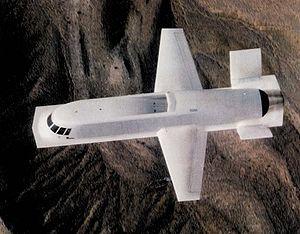Northrop Tacit Blue
| Tacit Blue | |
|---|---|

| |
| Role | Stealth demonstrator |
| Manufacturer | Northrop Corporation |
| First flight | February 5, 1982 |
| Retired | 1985 |
| Status | Retired |
| Primary user | United States Air Force |
| Number built | 1 |
The Northrop Tacit Blue was a
Development
Unveiled by the U.S. Air Force on 30 April 1996, the Tacit Blue Technology Demonstration Program was designed to prove that such an aircraft could continuously monitor the ground situation deep behind the battlefield and provide
In December 1976, DARPA and the U.S. Air Force initiated the Battlefield Surveillance Aircraft-Experimental (BSAX) program, which was part of a larger Air Force program called
Tacit Blue represented the "
The radar sensor technology developed for Tacit Blue evolved into the radar now being used by the
Tacit Blue was given the cover designation of "YF-117D" by the Air Force.[3][4]
Design

Tacit Blue, nicknamed "the whale" (and sometimes also called an "alien school bus" for its only slightly rounded-off rectangular shape),
Operational history

The aircraft made its first successful flight on February 5, 1982, in
Another Tacit Blue test pilot, Ken Dyson, told CNN in 2014 that Northrop had manufactured additional major components for the jet, which amounted to half of a second plane. "If we lost one, we could have a second one up and flying in short order," Dyson said.[10]
After reaching about 250 flight hours, the aircraft was placed in storage in 1985. In 1996, after Tacit Blue was declassified, it was placed on display at the National Museum of the United States Air Force at Wright-Patterson Air Force Base, near Dayton, Ohio and has been on display in the new fourth hangar at the museum since June 2016.[11]
Specifications
Data from [citation needed]
General characteristics
- Crew: 1
- Length: 55 ft 10 in (17.02 m)
- Wingspan: 48 ft 2 in (14.68 m)
- Height: 10 ft 7 in (3.23 m)
- Clark Y mod.[12]
- Gross weight: 30,000 lb (13,608 kg)
- Powerplant: 2 × Garrett ATF3-6 turbofanengines, 5,440 lbf (24.2 kN) thrust each
Performance
- Maximum speed: 250 kn (290 mph, 460 km/h)
- Service ceiling: 25,000–30,000 ft (7,600–9,100 m) operating altitude
- Thrust/weight: 0.36
See also
Aircraft of comparable role, configuration, and era
Related lists
- List of experimental aircraft
- List of military aircraft of the United States
- List of stealth aircraft
References
- ^ Assault Breaker Program Analysis.
- Flight Global.
- ISBN 978-3319029009.
- ^ "Cover Designations for Classified USAF Aircraft". www.designation-systems.net. Retrieved 2024-04-22.
- ^ Vartabedian, Ralph (26 February 1993). "Job Stress Catches Up With 'Dr. Stealth' of Aerospace : Science: Eccentric genius John Cashen's departure for Australia has many questioning the technology's future". L A Times. Retrieved 28 August 2018.
- ^ "Tacit Blue". CNet News. Photos: A brief history of stealth aircraft. November 23, 2007. Archived from the original on September 7, 2012. Retrieved 2 May 2012.
- ^ a b Grier, Peter (August 1996). "The (Tacit) Blue Whale". Air Force Magazine. Retrieved 25 August 2018.
- ^ Rogoway, Tyler (March 1, 2014). "Lockheed's Senior Peg: The Forgotten Stealth Bomber". Jalopnik.
- ISBN 978-0738576206.
- ^ Patterson, Thom (February 2014). "Area 51 Spy Plane and Other Aviation Tales". CNN. Retrieved 25 June 2020.
- ^ National Museum of the USAF Fact Sheet
- ^ Lednicer, David. "The Incomplete Guide to Airfoil Usage". m-selig.ae.illinois.edu. Retrieved 16 April 2019.
